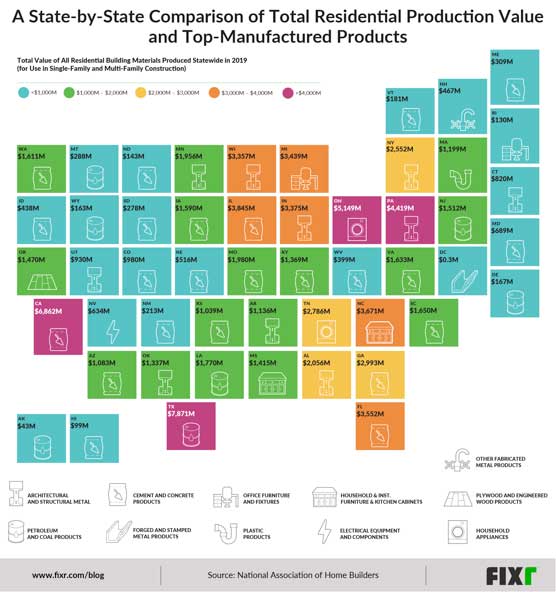The U.S. produced more than $88.5 billion dollars worth of building materials in 2019 – here’s what and how much states are producing.
By Yuka Kato
With many people nervous about the amount of goods being made overseas, it’s important to note that the construction industry is not only producing jobs at the building level, but also during the manufacturing of crucial materials as well.
By taking a comprehensive look at exactly what and how much states are producing, it’s possible to capture a better sense of the impact that the construction industry has on the economy as a whole. Below, you’ll find a map of the US, detailing the top manufactured products and the amount of building products each state generates in total, so you can more easily grasp the breakdown.

Map that shows the Total Residential Construction Production Value per State and the Top Manufactured Products.
The map is broken down not only by material, but also by how much revenue each state is producing. This is shown in color with the states in purple generating the most and the states in blue generating the least.
The top 10 producers include Texas, California, Ohio, Pennsylvania, Illinois, North Carolina, Florida, Michigan, Indiana, and Wisconsin. For many of those states, these construction statistics make sense. California and Texas both have very high populations, while Ohio, Pennsylvania, Illinois, Indiana, Michigan, and Wisconsin are all located in the industrial belt, which has historically had higher production numbers than other parts of the country.
North Carolina and Florida are the two states that do not fit either based on location or on residency, making their inclusion in the top 10 even more interesting.
Texas should also be noted for its position within the oil and petroleum products industry; the fact that it is the top producer of this material in the US cannot be overlooked, especially because of the amount of revenue the state generates. Following the same trend, it could be said that the resources of California are also part of its top production in cement and concrete products, while the steel industry in Pennsylvania could be the reason it also ranks so highly.
It’s also interesting to take a look at what the top products being manufactured are. All 50 states and the District of Columbia, which is overseen by congress with limited outside production, play some role in the manufacture of material for construction projects.
Looking at the various materials being produced shows some additional trends. Cement and concrete products are the biggest product being manufactured by a total of 22 states. This is followed by architectural and structural metal with 10 states and petroleum and coal products with 8 states.
Of the remaining 11 states, 5 have completely unique materials as their top product –
It’s interesting to note that those states whose top product is unique amongst other states’ top material, all are in the bottom third of total manufacturing revenue.
The remaining states and materials – Rhode Island (office furniture and fixtures), Ohio (household appliances), North Carolina (furniture and kitchen cabinets), Michigan (office furniture and fixtures), Tennessee (household appliances) and Mississippi (furniture and kitchen cabinets) are more mixed in terms of dollars produced.
When considering construction statistics and the impact of the construction industry as a whole on the economy, it’s important to consider all the ways in which this sector is creating jobs. While building labor and trades are definitely one way that the industry impacts the direct economy on an area and helps to create jobs, one cannot overlook the importance of the various states in their manufacture of the products that are used daily in building and construction.
From the factory to the building site, construction projects of all kinds are an integral part of the economy and the job market regardless of the state or what it produces.

Yuka Kato
Yuka Kato is an industry analyst at Fixr.com, a leading home improvement website dedicated to providing the most accurate cost guides and advice.
In this episode, I sat down with Beejan Giga, Director | Partner and Caleb Emerson, Senior Results Manager at Carpedia International. We discussed the insights behind their recent Industry Today article, “Thinking Three Moves Ahead” and together we explored how manufacturers can plan more strategically, align with their suppliers, and build the operational discipline needed to support intentional, sustainable growth. It was a conversation packed with practical perspectives on navigating a fast-changing industry landscape.